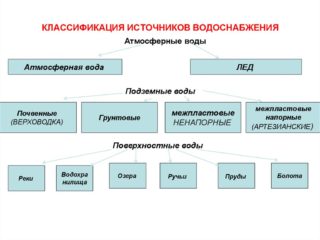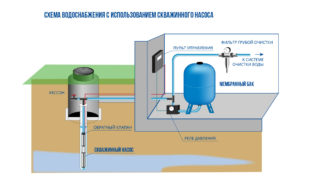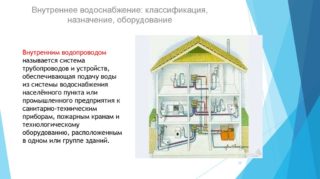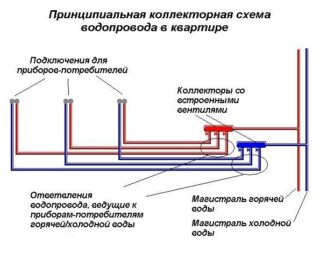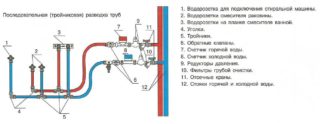Water supply is the process of providing hot and cold water to the population, industrial facilities, agriculture and fire extinguishing installations. If the complex of organizational and technical measures for water supply is organized correctly, consumers receive quality water on time and in the required volume, and the ecosystem is not disturbed.
Application area
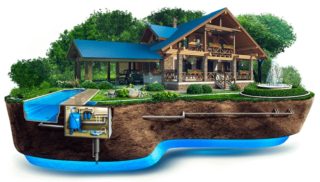
Water is used for different needs, which boil down to three parameters:
- for household and drinking consumption;
- for the operation of industrial facilities;
- for extinguishing fires.
This classification by purpose applies to all water supply systems. The fire-fighting network is additionally equipped with special equipment and hydrants. Usually it is made dead-end, so that the line can be combined with household and industrial supplies.
Drinking water supply is not compatible with objects that transport water for technical purposes.
According to the renewability of sources, water supply networks are divided into circulating and single use. The classification of water supply also implies a division into cold water supply systems and hot water supply systems.
Actual requirements
The quality of drinking water is regulated by SanPiN 2.1.4.1074-01. The main requirement of sanitary standards is that water should not pose a danger in epidemiological and radiation terms. It should be chemically harmless and have pleasant organoleptic characteristics. The quality of the aquatic environment must meet hygienic standards before being fed to distributors and taps of the water supply network.
With regard to technical standards for aquifers, SNiPs and TKPs impose the following requirements:
- supply of specified volumes of liquid to points of water consumption under the required pressure;
- high level of reliability and uninterrupted water supply;
- availability of utilities for water consumers;
- cost-effectiveness of projects of water supply systems, assuming a minimum of costs for arrangement and operation.
The fulfillment of the requirements is achieved by the competent selection of the configuration of the water supply system and the material of the pipes, as well as the correct determination of the technological and economic characteristics of all parts of the line.
Sources of water supply
Requirements for water supply sources:
- obtaining the required volumes of water, taking into account the increase in possible water consumption;
- uninterrupted provision of the population;
- achieving maximum quality by simple and inexpensive cleaning;
- low-cost water supply;
- minimal impact on the ecosystem.
The selection of a source is approached responsibly, because it determines the nature of the system, which determines the costs of its installation and operation.
The device of water supply systems
Centralized systems, as a rule, are executed in the form of ring networks, supplied with water from two or more water towers.This allows you to provide all water intake points in the event of an emergency, or to carry out repair work on a separate section of the water supply main.
Facilities for purification, intake and lifting of water supply it to consumers who are in their area of operation, according to a pre-agreed schedule. If connection to a citywide pipeline is not possible, it becomes necessary to equip an autonomous water supply network of a private house.
The creation scheme looks like this:
- A well or a well is equipped with a submersible pump, a water main is connected to it.
- The pipeline is laid and led into the house.
- The water supply network is connected to the cleaning filter element, the automation unit and the hydraulic accumulator.
From this system, the water supply system distributes clean water to consumers.
In places with regular power surges in the electrical network, the arrangement of water supply is carried out using a storage tank. The principle of operation of a decentralized system of this type is as follows:
- In the elevated part of the building, for example, in the attic, a storage tank equipped with a float valve is placed.
- The water supply is connected to a submersible pumping device, which is placed in a well or well.
- A branch from the source is led into the building.
- The home line is fed and connected to the bottom of the reservoir to accumulate moisture.
- By means of pumping equipment, liquid is pumped into the container. When it is completely filled, the pump automatically turns off.
- When the water drops to the lowest level, the valve is triggered and the pumping device starts to work again.
Non-centralized types of water supply are suitable for private houses with a small number of consumers. They are winter and summer. In the first case, the laying of the water supply system is carried out thoroughly in houses with permanent residence. The second option is suitable for seasonal work: automation of watering the garden, water supply to the shower room, country house, bathhouse. The installation cost is much less here.
A turnkey capital water supply system costs at least 85,000 rubles - perhaps for a summer residence it is worth stopping at the summer version. It is actually ten times cheaper to equip it.
Types of plumbing
The external system is assembled from devices that are responsible for purifying, storing water and pumping equipment. Filtration is carried out not only during suction, but also in the outermost water main.
If the branches of the water supply are carried out in an area with large relief differences, the device of a single network is irrational. When water is drained from the highest point in a low section, a strong pressure arises, which can damage communication facilities. In this case, equip the zone pipeline. The number of zones and methods of installing pumping equipment are determined depending on the terrain and the pressure of the water flow at each site.
The internal water supply consists of the main line and branches outgoing from it, which pass inside the building and are connected to the water intake points. To trace it, you need to carefully study the floor plans of the building, basement or technical underground.
Since the external water supply system can have different pressures, the water supply network inside the building is equipped according to two schemes:
| Network device | Water supply | Required elements | Features of operation |
| Without booster pumps. | Due to the pressure in the external line. | Input, water meter, pipes, riser and piping. | In most country houses and low-rise city buildings. |
| With pumps operating periodically or continuously. | Due to the action of pressure equipment. | In addition to those listed above, there is a booster pump or a pressure station. | In buildings over 50 m high, hotels, holiday homes and industrial facilities. |
The option with booster equipment is used when there is no necessary pressure in the external line to move the liquid, or if it is required to transfer it to elevated and remote water intake points.
Water dilution schemes
- sequential or tee;
- fan or collector;
- mixed - when combining the first two types in one room.
Each plumbing scheme has advantages and disadvantages. In the first case, the advantage is the ease of installation and cost-effectiveness, and the disadvantage is the dependence on the water pressure during its distribution to consumers. The second type ensures uniform pressure in all branch pipes. Each terminal can be independently overlapped without disrupting other consumers. The downside is the cost of building materials and the time spent on installation. The best option is the third type of distribution of trunk lines.
Water supply is a complex multifunctional process. In order for all systems and devices to work smoothly, you need to responsibly approach the design work, choose high-quality building materials and strictly observe the technology for installing highways.

